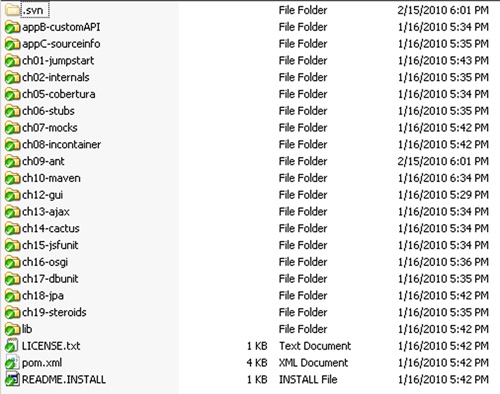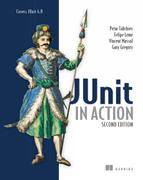Appendix C. The source code for the book
This appendix covers
- Installing the book’s source code
- Software versions required
- Directory structure conventions
This appendix gives an overview of the book’s source code, where to find it, how to install it, and how to run it. When we were writing this book, we decided to donate all of the book’s source code to the Apache Software Foundation, because we used many Apache frameworks in the making of this book. Therefore, we’ve made our source code available as open source on SourceForge at http://junitbook.sourceforge.net/junit2/.
We’re also committed to maintaining this source code and fixing it if bugs are found, as a standard open source project. In addition, a Manning author forum has been set up for discussing the code at http://www.manning-sandbox.com/forum.jspa?forumID=502.
C.1. Getting the source code
There are two possibilities for getting the source code on your local machine:
- Download a released version from http://sourceforge.net/project/showfiles.php?group_id=68011 and unzip it somewhere on your hard drive.
- Use an SVN client and get the source from SVN HEAD. Getting the source from SVN is explained at http://sourceforge.net/svn/?group_id=68011. Either way, place the source code in a local directory named junitbook2/ (for example, C:junitbook2 on Windows or /opt/junitbook2 on UNIX).
C.2. Source code overview
Once you put the source code in the junitbook2/ directory, you should have the directory structure shown in figure C.1. Each directory represents the source code for a chapter of the book (except the repository/ directory, which contains external JARs required by the chapter projects). The mapping between chapter names and directory names is listed in table C.1.
Figure C.1. Directory structure for the source code, shown here in Windows Explorer. (Note that the directory and file icons are decorated by the TortoiseSVN client.)

Table C.1. Mappings between chapter names and source directory names
|
Chapter name |
Directory name |
|---|---|
| Chapter 1: JUnit jump-start | junitbook2/ch01-jumpstart/ |
| Chapter 2: Exploring core JUnit | junitbook2/ch02-internals/ |
| Chapter 3: Mastering JUnit | |
| Chapter 4: Software testing principles | |
| Chapter 5: Test coverage and development | junitbook2/ch05-coberturra/ |
| Chapter 6: Coarse-grained testing with stubs | junitbook2/ch06-stubs/ |
| Chapter 7: Testing with mock objects | junitbook2/ch07-mocks/ |
| Chapter 8: In-container testing | junitbook2/ch08-incontainer/ |
| Chapter 9: Running JUnit tests from Ant | junitbook2/ch09-ant/ |
| Chapter 10: Running JUnit tests from Maven2 | junitbook2/ch10-maven/ |
| Chapter 11: Continuous integration tools | |
| Chapter 12: Presentation-layer testing | junitbook2/ch12-gui/ |
| Chapter 13: Ajax testing | junitbook2/ch13-ajax/ |
| Chapter 14: Server-side Java testing with Cactus | junitbook2/ch14-cactus/ |
| Chapter 15: Testing JSF applications | junitbook2/ch15-jsfunit/ |
| Chapter 16: Testing OSGi components | junitbook2/ch16-osgi/ |
| Chapter 17: Testing database access | junitbook2/ch17-dbunit/ |
| Chapter 18: Testing JPA-based applications | junitbook2/ch18-jpa/ |
| Chapter 19: JUnit on steroids | junitbook2/ch19-steroids/ |
Each directory maps directly to a project. A project is a way to regroup Java sources, test sources, configuration files, and so on under a single location. A project also has a build, which lets you perform various actions such as compiling the code, running the tests, and generating the Javadoc. We use various build tools (Ant and Maven) for the different projects, as explained in the chapter matching each project.
C.3. External libraries
You may have noticed a directory named repository/ in figure C.1. It contains the different external libraries (JARs) that all the other projects need in order to compile and run. As a convenience, we make them readily available to prevent you from having to fish for them all over the Net.
C.4. JAR versions
Table C.2 lists the versions of all external JARs and applications used in the projects. We recommend using these versions when you try the book examples.
Table C.2. External JAR/application versions (sorted in alphabetical order)
|
Version |
Project URL |
|
|---|---|---|
| Ant | 1.7.1 | http://ant.apache.org/ |
| Cactus | 1.8.1 | http://jakarta.apache.org/cactus |
| Commons BeanUtils | http://commons.apache.org/ | |
| Commons Collections | http://commons.apache.org/ | |
| Commons HttpClient | http://commons.apache.org/ | |
| Commons Logging | http://commons.apache.org/ | |
| DBUnit | 1.5.5 | http://dbunit.sourceforge.net/ |
| EasyMock | 1.0 | http://easymock.org/ |
| Eclipse | 3.5.2 | http://eclipse.org/ |
| HttpUnit | 1.5.3 | http://httpunit.sourceforge.net/ |
| Jakarta Taglibs/JSTL | 1.0.2 | http://jakarta.apache.org/taglibs/ |
| JBoss | 4.2.1 | http://jboss.org/ |
| Jetty | 7.0.0.pre5 | http://jetty.mortbay.org/ |
| JUnit | 4.6 | http://junit.org/ |
| Maven | 2.0.10 | http://maven.apache.org/ |
| MockObjects | 0.09 | http://mockobjects.com/ |
| ServletAPI | 2.5 | http://repo1.maven.org/maven2/javax/servlet/ |
| Tomcat | 6.0.14 | http://tomcat.apache.org/ |
C.5. Directory structure conventions
For each project, we followed the directory conventions listed in table C.3.
Table C.3. Directory structure conventions
|
Directory name |
Explanation |
|---|---|
| <project name>/src/main/java | Java runtime sources. |
| <project name>/src/test/java | Java test sources. |
| <project name>/src/main/webapp | Web app resources (JSPs, web.xml, taglibs, and so on). |
| <project name>/src/main/conf | Configuration files (if any). |
| <project name>/target | Directory created by the build process (Ant or Maven) to store generated files and temporary files. It can be safely deleted, because it’s re-created by the build. |
